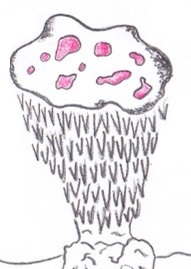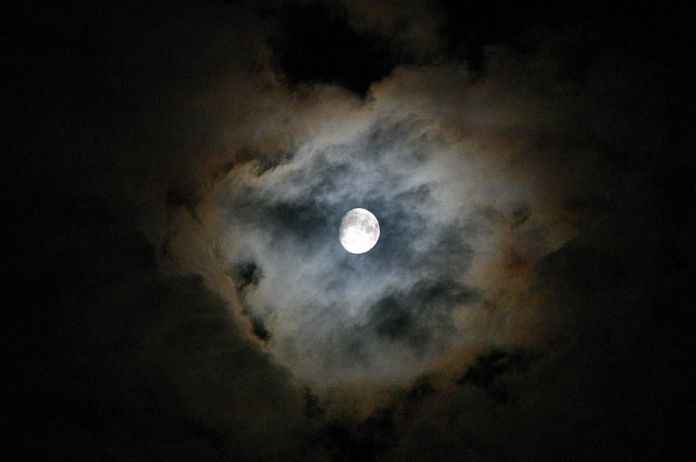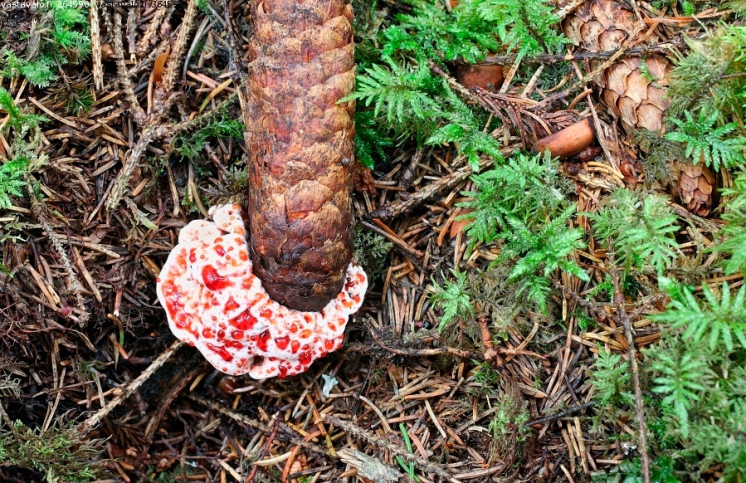
Spooky Story
Picture yourself, alone, in the middle of a dense coniferous forest
in the Pacific Northwest. You are out for a moonlit stroll and have
become lost. The eerie howl of a wolf resonates through the forest
around you. You start to get the feeling someone or something is
watching you. A sudden rustling erupts from a nearby patch of
ferns which startles you and causes you to dash in the opposite
direction. After running for a short period of time, you trip
over an exposed tree root and tumble to the ground. As you position
yourself to stand back up, you notice something twinkling in your
peripheral vision. You crane your neck to get a better look. Now you
behold, lying on the ground inches from your face, a creature loaded
with serried fangs and blood oozing from exposed flesh on its head.
The abominable, blood-soaked H. peckii glistens before you in the
moonlight.
When you first hear of H.peckii's common name, the bleeding tooth fungus, a couple of grotesque interpretations may come to mind. You may imagine a fungus that literally looks like a bleeding tooth, or a nasty oral fungus that causes bleeding teeth. However engaging such construals may be, the term bleeding tooth fungus instead refers to the fact that H.peckii is a hydnoid (tooth) fungus that exudes ("bleeds") a blood-like substance. But, if H.peckii is a fungus, and fungi don't have blood, what's the bloody liquid produced by H.peckii?
Based on
mass spectroscopy data, the
conspicuous scarlet pigment primarily responsible for the color of
the bloody fluids secreted by H.peckii is an
unidentified compound with a molecular weight of 389.4 g/mol. In
Hydnellum sp. this mystery compound is always correlated with
another unknown compound with a molecular weight of 430.2 g/mol. Samples
containing mostly compound 389 were found to be deep red, while
samples containing predominantly compound 430 were found to be brown.
Accordingly, compound 389 was determined to be the red pigment and
compound 430 is
hypothesized to either be a precursor to the molecule 389 (red
pigment) or to somehow integrate molecule 389
and change its color
in doing so. Additionally, pigments including aurantiacin(red-orange), atromentin(brown), and thelephoric acid
(black) have been
isolated from H.peckii fruiting bodies and likely contribute
some to the hue of H.peckii's exudates (Westmoreland,
2003). The broad spectrum of colors in the photograph of H. peckii
to the left is a result of a blend of the aforementioned pigments. Beyond that, the origin of the H. peckii's
faux-blood remains somewhat of a mystery.
The indeterminate growth of H. peckii is also rather spooky. As mentioned in Reproduction, H peckii is not restricted to a particular growth form and can grow amorphously to swallow anything in its vicinity . Twigs, pinecones, grass, and a portion of you too could theoretically be swallowed by H. peckii . I don't know about you, but I find the notion of being partially engulfed by a fanged organism oozing blood from its head to be quite spooky.
Assuming you nearly died from terror learning about the spooky side of H.peckii, maybe learning about some of H.peckii's medical applications would be apropos.


